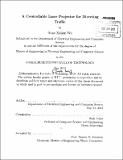| dc.contributor.advisor | Seth Teller. | en_US |
| dc.contributor.author | Wu, Brian Xiuken | en_US |
| dc.contributor.other | Massachusetts Institute of Technology. Department of Electrical Engineering and Computer Science. | en_US |
| dc.date.accessioned | 2014-03-06T15:48:13Z | |
| dc.date.available | 2014-03-06T15:48:13Z | |
| dc.date.copyright | 2013 | en_US |
| dc.date.issued | 2013 | en_US |
| dc.identifier.uri | http://hdl.handle.net/1721.1/85524 | |
| dc.description | Thesis: M. Eng., Massachusetts Institute of Technology, Department of Electrical Engineering and Computer Science, 2013. | en_US |
| dc.description | Cataloged from PDF version of thesis. | en_US |
| dc.description | Includes bibliographical references (pages 125-127). | en_US |
| dc.description.abstract | For this Master's thesis, I designed and implemented a combined laser and controller system that can receive and convert commands from a computer into useful laser projections. In the last 10 years, on average, one police officer, who is conducting a vehicle stop or directing traffic, is struck and killed by an oncoming vehicle per month in the United States. Most of these instances occur at night. Current literature proposes that for some drivers, especially those who are fatigued, the combination of bright, rapidly flashing emergency lighting causes them to drive closer to a emergency vehicle rather than away from it. An effective solution to this problem is to extend the visual range of warning lights. Existing methods of lane diversion are time consuming, bulky and/or dangerous to deploy. The project is a system that allows the officer to quickly delineate a series of laser points to simulate a line of road-side flares. This will result in a commonly-used, perceptually salient visual signal that will induce traffic away from the cruiser. The controller interfaces with the police officer's computer over a USB 2.0 interface. Internal EEPROM allows the system to store up to 100 unique coordinates and intensities. The communication protocol is handled with the SerialPy library. Testing and calibration of the laser projector is integrated with a simple UI and rear-facing cameras. The UI also allows the user to select arbitrary points for the laser spots to be projected on to, creating a series of virtual flares. Using a cylindrical lens to expand the laser beam and reduce divergence, we were able to focus the laser spot accurately to 50m, increasing optical power density and increasing visual recognition at a distance. The laser output power can be configured from 0.2mW to 1W using a PWM driver. | en_US |
| dc.description.statementofresponsibility | by Brian Xiuken Wu. | en_US |
| dc.format.extent | 127 pages | en_US |
| dc.language.iso | eng | en_US |
| dc.publisher | Massachusetts Institute of Technology | en_US |
| dc.rights | M.I.T. theses are protected by copyright. They may be viewed from this source for any purpose, but reproduction or distribution in any format is prohibited without written permission. See provided URL for inquiries about permission. | en_US |
| dc.rights.uri | http://dspace.mit.edu/handle/1721.1/7582 | en_US |
| dc.subject | Electrical Engineering and Computer Science. | en_US |
| dc.title | A controllable laser projector for diverting traffic | en_US |
| dc.type | Thesis | en_US |
| dc.description.degree | M. Eng. | en_US |
| dc.contributor.department | Massachusetts Institute of Technology. Department of Electrical Engineering and Computer Science | |
| dc.identifier.oclc | 871040428 | en_US |
